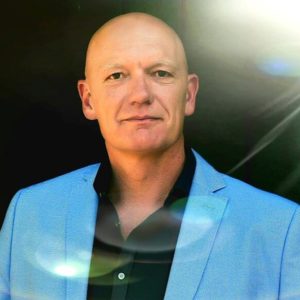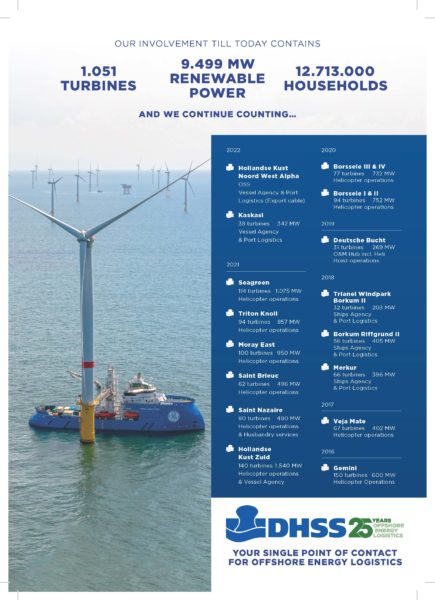Door Teun Hoek
Tonnie Schuijl is drie jaar werkzaam bij Den Helder Support Services (DHSS). Hij heeft meer dan dertig jaar ervaring in verschillende managementfuncties in de Renewable Energy, Offshore, Solar, Oil en (groen) gas, is direct verantwoordelijk (CCO) voor de locatie van DHSS in de Eemshaven en neemt daarnaast plaats in het managementteam te Den Helder. DHSS is opgericht in 1997 door Wim Schouwenaar en richt zich voornamelijk op de offshore wind sector. Den Helder was indertijd de belangrijkste logistieke havenvestigingsplaats.

Over DHSS
DHSS is een logistiek dienstverlener die een aantal belangrijke services biedt om offshore klanten vooral te ontzorgen; Scheepsagentuur, Warehousing, Logistiek, Douane en Luchtvaart. Het grootste deel van het werk vindt dus in de havens plaats, maar ook bijvoorbeeld op windparken uit de kust. Zo leveren ze bijvoorbeeld helikopters services. Ze faciliteren van aanvraag tot het charteren van een heli voor de betreffende vlucht. Ook wordt er de laatste tijd veel gepraat over de inzet van drones. Het vervoeren van een pakketje is daarmee goedkoper en efficiënter. Een ander alternatief zijn zogenoemde Crew Transfer Vessels (CTV’s), waarmee technici vanuit een haven naar de betreffende boot worden gebracht.
Waar DHSS ook veel voor wordt gevraagd zijn douanewerkzaamheden en het gereed maken van de benodigde documenten voor in- en uitvoer. In vooral het administratieve en juridische werk gaat veel tijd zitten, omdat dit nauwkeurig en uitvoerig moet gebeuren. Gelukkig hebben zij deze expertise in huis.
DHSS heeft een groot bestand van (vaste) leveranciers waarmee wordt samengewerkt. Het voordeel hiervan is dat je weet wat je van elkaar kunt verwachten. Wat DHSS levert is uniek: het totale service pakket binnen de offshore keten. Dit moet bijdragen aan het totaal doel: het creëren van ‘one stop shop’. Oftewel, alle leveringen vanuit één leverancier op een centrale en fysieke locatie organiseren. Je dienstverlening instellen op een complementaire keten.
In 2019 is in de Eemshaven het project OWIC gestart. DHSS was één van de initiatiefnemers en betrokken bij de invulling van de werkpakketten. DHSS leidt het werkpakket rondom kabels, het Cable Centre Eemshaven. Tonnie vertelt dat ze een geheel nieuw kenniscentrum rondom kabels gaan neerzetten, waarmee ze kabelleveranciers willen uitdagen om aan te sluiten. Het belangrijkste doel is van kennisvergaring tot uitvoering van het aanleggen van de kabels.
DECOM North
Een offshore wind park bestaat eigenlijk nooit langer dan 20 jaar. Daarna wordt het ingehaald op innovatie, capaciteit of zijn simpelweg de vergunningen verlopen. Dat biedt uitdagingen in het circulair maken van de windsector. Je wilt natuurlijk niet dat al het materiaal verkeerd zal worden opgeslagen. Een mooi voorbeeld is de toekomstige proeffabriek van het samenwerkingsverband Decom North. Daarbij worden materialen van afgeschreven windmolens ontmanteld en de rotorbladen vervolgens vervoerd naar de nieuwe recyclingfabriek bij de Eemshaven. Hieruit komen grondstoffen voor de productie van nieuwe onderdelen voort. Volgens Tonnie is dit een uniek en nog nergens anders vertoond proces.
Groeien en samenwerken
Er is een enorme groei te zien in de offshore wind. OWIC draagt honderd procent bij aan de innovatie van de offshore wind keten. Doel is om partijen bij elkaar te brengen, de ‘we’ gedachte krijgen. Daar liggen nog wel uitdagingen, aldus Tonnie. Veel partijen zijn gewend enkel voor eigen gewin te opereren, maar om dingen te bereiken is meer samenwerking noodzakelijk. Oftewel, om je heen kijken wie kan aansluiten, welk bedrijf heeft waar expertise in, etc. Daarom sluit DHSS ook niemand uit. Belangrijkste vindt Tonnie om vanuit de behoefte van de klant te denken. Uiteindelijk dient die ontzorgd te worden.
De eerste stap is om de business in de offshore energy te vergroten. OWIC kan daarin een concrete bijdrage leveren door kennis te delen, het aanbieden van opleidingen/trainingen, het vinden van geschikte mensen en het efficiënter inrichten van logistieke processen. Voor nu, maar vooral voor morgen.
Visie bepalen op een onrustige markt
Processen moeten op gang komen, je moet proberen om met betrokken partijen visie te bepalen ‘waar wil ik over 10 jaar staan’. Daarom heb je aan de voorkant altijd bedenkers nodig. We zijn nu (2022) op een punt aangekomen dat naar versnelling wordt gezocht.
Het grootste risico vandaag de dag is volgens Tonnie de totale onbalans die op de markt is ontstaan door onrust en onzekerheid. Daardoor kun je bijna niet voorspellen wat er morgen gebeurt. Gebeurtenissen als de oorlog in Oekraïne en het coronavirus hebben ook een grote impact op de energietransitie. Het sentiment ‘we gaan niet morgen, maar vandaag bouwen aan een groenere planeet’ leeft daardoor veel meer. Daar zal ook de offshore wind van profiteren.
Er zijn hiervoor snel groene investeringen nodig, zegt Tonnie. Op dit moment is drie gigawatt aan duurzame energie in Nederland beschikbaar. Dat moet 30 gigawatt worden in 2040. Daarom moeten we nu als havenbedrijven in combinatie met de eigenaar (in de Eemshaven is dat Groningen Seaports, red.) stappen zetten in hoe willen we ‘onze’ doelen gaan bereiken en welke strategische keuzes maken we daarin. Vooral het ‘WE’ moet hierin voorop staan. Samenwerken dus!


